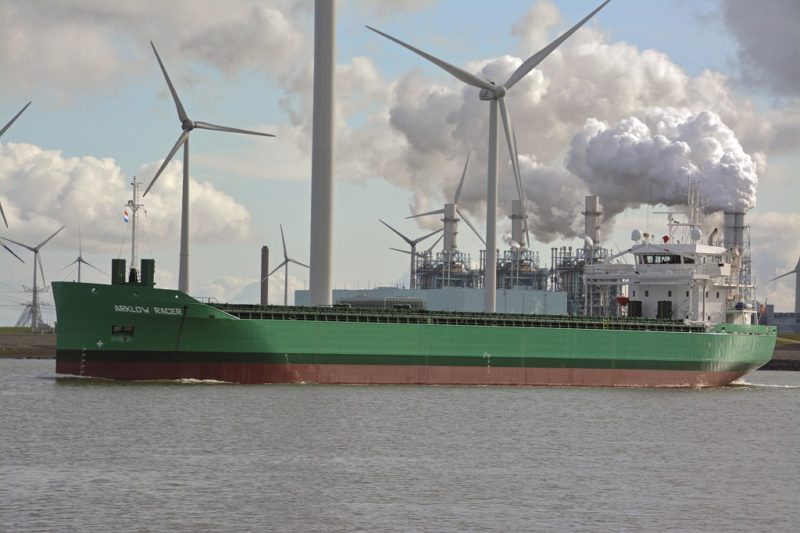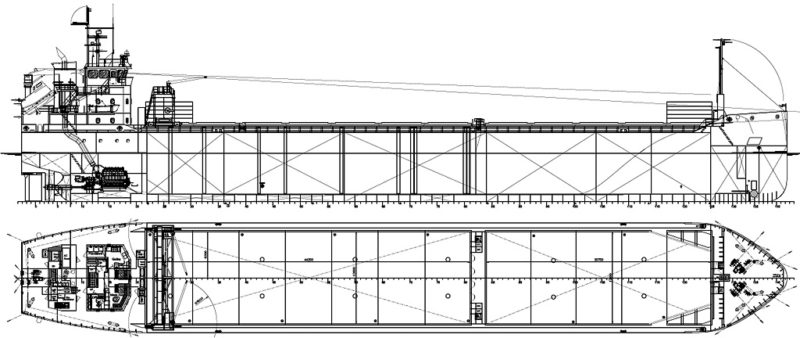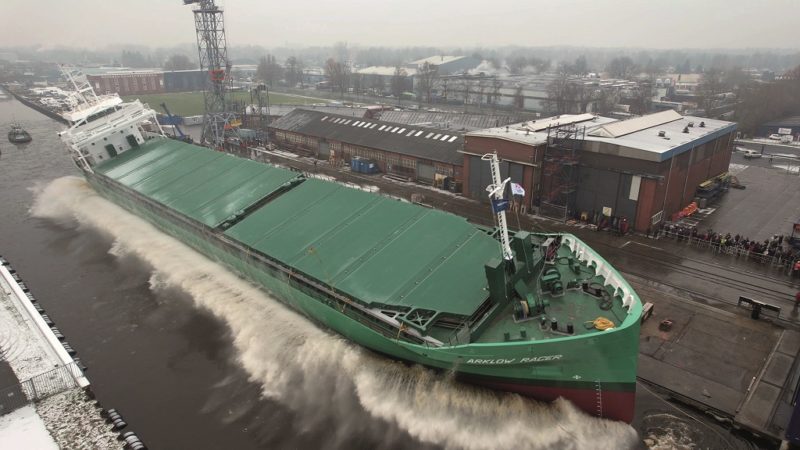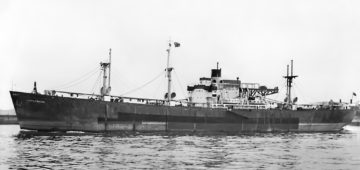
In early 2021 the Eco Trader 6800 emerged as part of the impressive range of dry bulk vessel designs offered by the Royal Bodewes Shipyard. As the name suggests, this class of vessel has a 6,800t deadweight (6,885dwt on the specifications). The overall length of these vessels is 104.93m with a waterline length of 102.98m, a moulded beam of 9.50m, a design draught of 6.60m and a gross tonnage of 4,267gt. The Eco Trader 6800 has two holds and an overall cargo capacity of 8,778m3 (310,000cft). Hold No. 1 is 30.75m long and 12.60m wide whilst Hold No.2 is 44.25m long and 12.60m wide. The free height in each hold is 9.29m. Hold No. 1 is located forward, occupying around 40% of the overall cargo space. A total of 12 pontoon-type hatch covers seal the hold whilst at sea and are removed/replaced using a 20t SWL capacity gantry crane that runs on rails up and down the weather deck and is stowed in front of the deckhouse when not in use. The cargo holds are designed for bulk cargoes, have two grain bulkheads and an A-60 engine room bulkhead is an optional extra, subject to the ship’s main use. The tank top has a deck load of 15 tonnes/m3 with the cargo hatch cover deck load not supplied but this is usually around 1.6 tonnes/m² on such a ship. The superstructure, located aft, consists of 4 levels with the Tween Deck level offering crew cabins and facilities plus en-suite accommodation for two officers. At Main Deck level in the deckhouse is the mess room, office, galley and pantry plus utility areas. One level up is the en-suite accommodation and day rooms for the Chief Engineer and Captain. The upper-most level (besides Top Deck) is the wheelhouse on the Bridge Deck. The accommodation is modern, attractive and practical, with each crewmember having a private cabin with en-suite facilities and air-conditioning. The machinery space is located aft and houses the MaK 6M25C 4-stroke marine diesel engine (6 cylinders in-line) that is IMO II compliant and has an output of 1,768kW/2,370hp and 750rpm. The 6M25C power unit is 5,345mm long, 2,261mm wide and 3,766mm high. The dry weight is 51,808kg and the displacement is 123,000cm3 (123 litres). The stroke is 400mm and the bore is 255mm. The engine drives a single Berg Propulsion controllable pitch propeller via a Renk gearbox with a loaded trials speed of 11.6 knots being recorded. Steering is via a hydraulically powered Benes rudder and a 300kW transverse tunnel bow thruster is fitted. The ship also has two 150ekW auxiliary engines and a 65ekW emergency generator.
Birthplace of the Eco Trader 6800, The Royal Bodewes Shipyard, dates to 1812 when Shipbuilder Geert Joosten Bodewes registered the company. The shipyard produced various types of wooden barges and coastal vessels. Geert’s second son, Wijnandus, became the second generation’s business leader and the business flourished. In 1882, he turned the management of the shipyard over to his sons Geert and Harmannus. In addition to the traditional timber construction, the company introduced ironclad and later steel-clad vessels. Some of these are still in operation. In 1908 the focus turned to steamships and, in 1911, the two brothers (whose company was now called G. & H. Bodewes) transferred the leadership of the company to their oldest sons Herman and Nandus. The introduction of the diesel engine led to the construction of motorised barges and coastal vessels. NB 606 was launched on 18th May 1916. In January 1918 the vessel was sold to her first owner Holmen Bruks & Fabriks, Norrköping where she was used for towing wood to the paper factories in Norrköping or in Hallstavik. In 1969 the vessel was sold to the captain and was renamed Holmvik. In 1976 the vessel was sold to the AVRO (a Dutch television organisation) and was renamed Furie. After being used for a television series, she was sold to the foundation Hollands Glorie and the vessel even has her own website. In 1924, the company was expanded by the purchase of a shipyard in the town of Hasselt. After the Dortmund-Ems Canal was opened, the Hasselt and Martenshoek shipyards produced dozens of ‘Dortmunders’. The first wholly engine powered coastal vessels were built in 1931. In the 1970s, an imposing construction hall was built at the shipyard, and, for several decades, the shipbuilding business also operated its own shipping company with an average fleet of five vessels. In 1986, when the shipyard management no longer had family members to serve as successors, it was transferred to non-family members. In 1988, the company signed a contract to build two multi-purpose ro-ro vessels. These were the very first of their kind, so the shipyard found itself designing technically advanced parts like loading flaps and loading lifts without any frame of reference. The 4,250dwt ship was introduced to the world in 1990 and six were built.
The new millennium brought a succession of new ship types designed by Bodewes that responded perfectly to the needs of the market. In 2010, Bodewes Shipyards and Universal Africa Lines arrived at a partnership for the building and operating of the Eco Trader 8700 series of ships. In 2012, the shipyard celebrated its 200th jubilee and received the honourable title of ‘Royal’ on this occasion. On 30th November that year her majesty’s provincial governor Mr Max van den Berg officially granted the honourable predicate of ‘Royal’ at the Hoogezand shipyard on behalf of the Queen of the Netherlands. Since then, the Bodewes Shipyards have been known as Royal Bodewes. Another building hall was added to the site and the waterway next to the shipyard, the Winschoterdiep Canal from Groningen, was widened for the purpose of launching newbuilds sideways. The shipyard now has an impressive portfolio of designs for cargo vessels in a range of 1,500dwt up to 15,000dwt not to mention specific vessel types such as oil tankers, paper carriers, LNG carriers, cement carriers and tugs. At the time of writing there were 158 general cargo ships listed on the shipyard’s website, an impressive array indeed. Arklow Shipping Limited was the first customer for the 6800dwt Eco Trader class and Yard No.821 became another example of 21st century shipbuilding at the yard when the newbuild, named Arklow Racer, was launched transversely on 16th December 2022 into the canal. The waterway is adjacent to the Royal Bodewes shipyard in Martenshoek, Hoogezand near Groningen. Unusually, the launch was a silent ceremony with no official naming, Godmother present etc. The launch of the Arklow Racer, the first of seven new R-Series ships (NB 821-827) marked a return to Royal Bodewes yard by Arklow Shipping Ltd. as some of their previous orders had been handled by compatriot shipbuilder Ferus Smit Shipyard. The latter had previously built 6 of the A-Series ships for Arklow Shipping, 2020-2021, and a further 10 examples of the C-Series were completed 2016-2022. The final example of the C-Series was the 2,999gt/2022-built Arklow Crest. The first ships built by Royal Bodewes for Arklow Shipping were the 4,723gt/2011-built Arklow Bridge, renamed Aasvik in December 2017 when sold to Aasen Bulk, and the 4,723gt/2011-built Arklow Brook, renamed Norheim in July 2021 when sold to Arriva Shipping AS.

Royal Bodewes has also delivered 10 V-Series vessels in the form of the 2,999gt Arklow Vale (2015), Arklow Valiant (2016), Arklow Valley (2016), Arklow View (2016), Arklow Valour (2017), Arklow Vanguard (2017), Arklow Venture (2017), Arklow Venus (2018), Arklow Viking (2018) and Arklow Villa (2018). As will have been noticed, the vessel naming nomenclature is based on a nominated letter, i.e V for the aforementioned sisterships and R for the newbuilds in 2023-24. The Arklow Racer might be the premier example of the Eco Trader 6800 series, and the first of the new generation R-Series ships but the name Arklow Racer was previously carried by the 2,999gt/2004-built Feed Rogaland, operated by Halten Bulk AS since May 2019. The ship is still owned by Arklow Shipping Limited’s sister company, Invermore Shipping Limited. The previous 2,999gt R-Series members were built 2002-2007 with only 4 still operational in early 2023. (Arklow Raider/Rainbow/Raven/Rogue) These 4,400dwt vessels numbered 16 in total, with the other examples being the Arklow Racer, Rally, Rambler, Ranger, Rebel, Resolve, Rival, River, Rock, Rose, Rover and Ruler.
Arklow Shipping was founded in 1966 by Captains James Tyrrell, Michael Tyrrell and Victor Hall to enable them to operate their combined fleet of 7 ships, namely the 244grt/1935-built Tyrronall, 319grt/1940-built Murell, 418grt/1948-built Marizell, 576grt Valzell (purchased in 1960), 321grt/1942-built Kilbride, 384grt/1948-built River Avoca and the 303grt/1950-built Avondale. Arklow Shipping Limited became the trading name in 1970 with the first coaster to be registered under the company being the 299grt Arklow. As the name suggests, the company is based in Arklow, Ireland. Arklow takes its name from the meaning “the great estuary,” is a town in County Wicklow on the southeast coast of Ireland and located at the mouth of the River Avoca, the longest river wholly within County Wicklow.
The shipping company is a leader within Europe in the dry bulk trade, with chartering teams based in Arklow and Rotterdam. The company also has a long-term relationship with many of Europe’s multinational trading groups and is continually updating and enlarging its fleet to meet customer requirements. Two dedicated teams of shipbrokers manage all aspects of vessel chartering for the company and the transportation/logistics team handles the shipment of project cargoes, offshore structures, offshore and landline pipes, bulk grain trades, dangerous bulk cargoes, steel rails, minerals and general cargoes. Nowadays the company has a fleet of modern single deck, box hold and container fitted vessels ideally suited for the carriage of an array of bulk commodities including those classified under IMO regulations. At the time of writing, Arklow Shipping operates a modern fleet of around 55 ships in sizes ranging from 4,200gt to 35,000gt. The other short-sea classes in the new millennium have been the B, C, D, F, M, V and W Series. Deep sea shipping was added to the company’s portfolio in 2011 when the 22,868gt Arklow Spray and Arklow Spirit were ordered and delivered in 2013/14. Besides this duo and the new R-Series, the fleet consisted at the time of writing of six 5,078gt A-Series, six 5,065gt B-Series, ten 2,999gt C-Series, four 2,998gt F-Series, one 2,999gt G-Series (Arklow Gem, in-build), six 9,758gt M-Series, four old generation 2,999gt R-Series, ten 2,999gt V-Series and four 9,999gt W-Series.
The 4,267gt Arklow Racer undertook her sea trials from Eemshaven/Delfzijl in The Netherlands and was delivered on 17th February 2023. The new ship is due to be joined by the Arklow Rally, Rambler and Ranger in 2023 with the Arklow Resolve, Rose and Rover marked for delivery in 2024 to complete the order. The fleet will then exceed 60 ships if older examples are not withdrawn before the Arklow Rover is delivered.








Comments
Sorry, comments are closed for this item